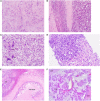Pathology of Cholangiocarcinoma and Combined Hepatocellular-Cholangiocarcinoma
- PMID: 33968385
- PMCID: PMC8087927
- DOI: 10.1002/cld.1047
Pathology of Cholangiocarcinoma and Combined Hepatocellular-Cholangiocarcinoma
Figures






References
-
- Nakanuma Y, Klimstra DS, Komuta M, et al. Intrahepatic cholangiocarcinoma. In: WHO Classification of Tumors: Digestive System Tumors. 5th ed. Lyon, France: IARC Press; 2019:254‐262.
-
- Roa JC, Adsay NV, Arola J, et al. Carcinoma of the extrahepatic bile ducts. WHO classification of tumors: Digestive system tumors, 5th edn. Lyon, France: IARC Press; 2019:289‐291.
-
- Bergquist A, Seth E. Epidemiology of cholangiocarcinoma. Best Pract Res Clin Gastroenterol 2015;29:221‐232. - PubMed
-
- Abu‐Wasel B, Keough V, Renfrew PD, et al. Biliary stent therapy for dominant strictures in patients affected by primary sclerosing cholangitis. Pathobiology 2013;80:182‐193. - PubMed
Publication types
LinkOut - more resources
Full Text Sources

